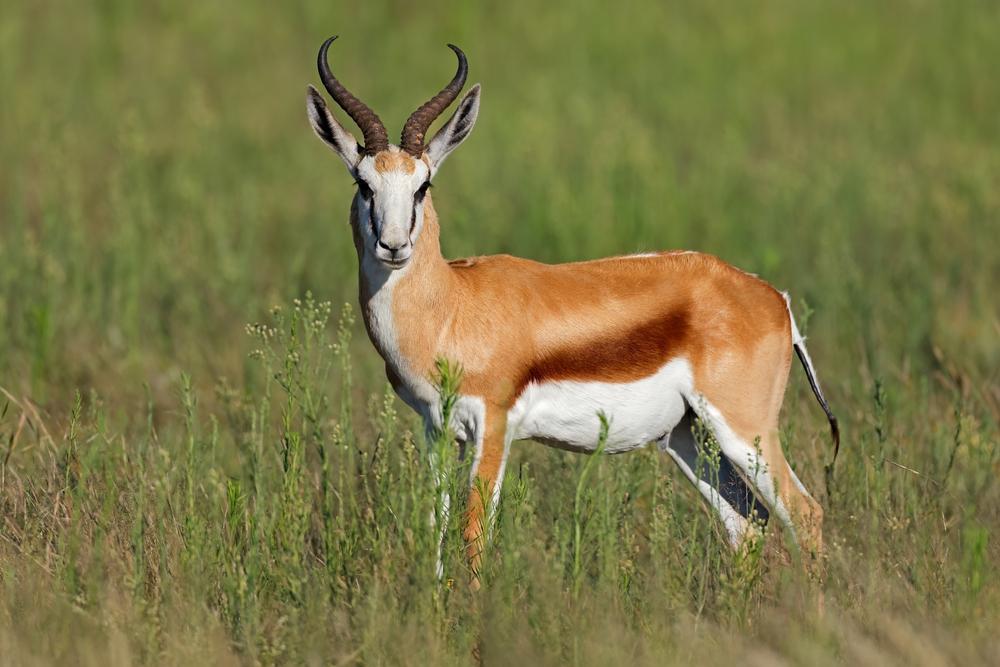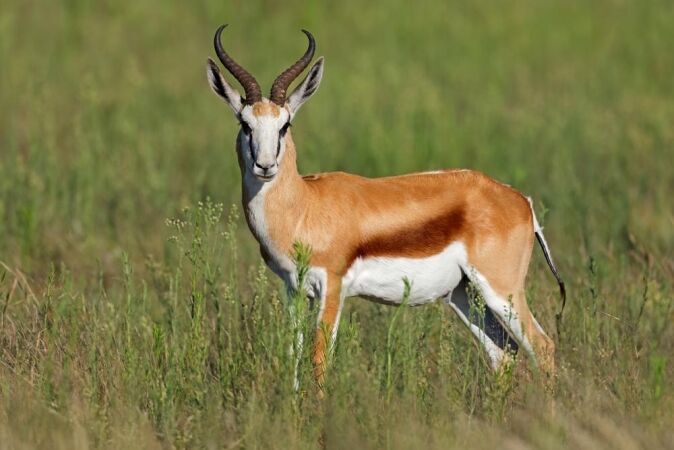

The springbok (Antidorcas marsupialis) is a medium-sized antelope found in Southern Africa. In South Africa itself, it is the most commonly found antelope in the central and western parts of the country and a popular choice when hunting in South Africa. The IUCN lists their conservations status as “least concern.”
Springbok hunting in Africa occurs in Southern Africa’s most arid regions, namely South Africa, Namibia and Botswana. Springbok hunting in South Africa is often part of an African plains game package, including kudu, sable antelope, gemsbok, impala, blesbok, warthog, and mountain reedbuck, to name a few.
Springboks breed all year round, but there is a peak in the rainy season. The ewe gestates for 5-6 months and gives birth to a single calf. The calf weans at about six months and leaves its mother a few months later.
Springboks are herbivores, consuming a diet of shrubs, succulents, and a variety of grasses. They can go for days without drinking, and sometimes may not drink any water at all during their entire life span. They gain moisture by selecting a variety of flowers, seeds and shrubs and consuming them when they are most succulent and moisture-ridden.
The springbok has a unique pronking or stotting behaviour that is characterised by their ability to straighten their legs, making them rigid as they jump. This propels them high into the air as if they were bouncing along. These jumps or leaps can reach remarkable heights of up to 6 feet at a time! This, together with their speed where they reach up to 55 miles per hour, assists them in evading predators.
The springbok has many predators preying on it, including lions, leopards, cheetahs, spotted hyenas, caracals, crocodile, wild dogs, and pythons. Juveniles are preyed on by smaller carnivores such as raptors, black-backed jackals, and African wildcats.
Name:
Antidorcas Marsupialis
Male Weight:
72-105 pounds
Male Shoulder Height:
27-35 inches
Mating:
Year round
Range:
Southern Africa
Gestation Period:
5-6 months
Life span:
7-9 years
Springboks are Herbivores, Consuming a Diet of Shrubs, Succulents, and a Variety of Grasses
When hunting in South Africa, look for a striking, medium-sized antelope with a white face and a dark stripe running from the eyes to the mouth. It has a light brown coat with a darker reddish-brown stripe running across the lower third of its body and a white rump. Both sexes have horns, with the male’s horns being thicker than the females. The springbok male is slightly larger than the female, weighing 72-108 pounds compared to the female at 66-97 pounds. The male stands approximately 27-35 inches at the shoulder.
Springbok hunting in South Africa is completed using the walk and stalk technique. This can be challenging, as the springbok is adept at camouflaging itself from predators and potential danger.
Springboks, when nervous or frightened, tend to bunch together, making it difficult for a hunter to differentiate between males and females on the game hunting safari. It is also a challenge, due to them standing so closely together, to be able to easily identity a trophy specimen.
Choose a flat shooting rifle with a minimum caliber of 25 caliber (i.e., 243 or .270) for your game hunting expedition. The bullet tip needs to weigh not less than 120 grains and travel at 2600 feet per second. If meat damage is not a concern, a 308, 7mm, or 300 win-mag is a suitable choice for the trophy springbok.
Search from our range of Hunts across various popular destinations in Africa.
Find A Hunt